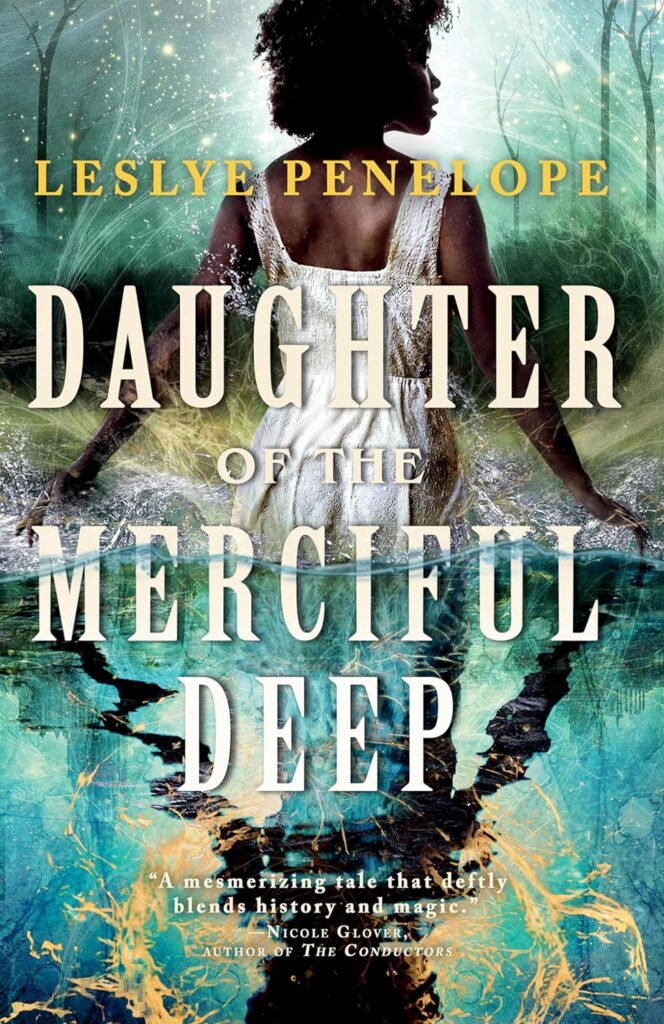After yet more downtime caused by, first, the misery of a post-covid illness, something like a cold from hell, and then happy times during a special family birthday gathering, I managed to start reading again with Daughter of the Merciful Deep by Leslye Penelope. I was so impressed with her earlier The Monsters We Defy that I immediately grabbed an e-arc of this new historical fantasy novel. As in The Monsters We Defy, Penelope has created a wonderful character from mention in a court proceeding of a real person. She takes us to the depression-era American South at a time when dams were being built by the federal government throughout the Tennessee Valley. In this story, the Authority sends out dozens of white-shirted, fedora-hatted bureaucrats to buy or seize land from the people of a prosperous black community named Awenasa. But a twenty-three year-old woman named Jane Edwards and many other residents are not about to let their town disappear under water.
Jane narrates most of Daughter of the Merciful Deep, but she has a hard time opening up to anyone about a dark part of her life. She harbors a secret so shameful and damning in her mind that it has deprived her of the power of speech. Since she was a teenager, she has not been able to use her voice and communicates by signing and writing down her side of a conversation. But even worse, she thinks she is unworthy of having a normal life, of accepting positions of responsibility that people keep asking her to take on or admitting to her deep feelings for her friend Daniel. So, as lively and alert to the good in others as she is, Jane has locked up a deep part of her soul that cuts her off from living a full life. As becomes clear soon enough, the trauma she experienced was not of her doing but the psychic damage resulting from coercion at the hands of powerful white people.
Nevertheless, as she puts it, she feels like she barely has control over her body. Not only has she lost the use of her voice, but at times her whole body locks up, and she can’t take a step. A hidden shame makes her feel like she just wants to get lost and then discover someone new that she could be. Daughter of the Merciful Deep, among many other things, is the story of that discovery.
One day Jane spots a man in town, dressed in a spotless linen suit and carrying a briefcase, who bears an uncanny resemblance to someone from her past. He calls himself Moses now, but he looks exactly like the long-dead Rob Knox, the man her older sister Grace had once intended to marry. As she follows him through town, she sees him struck down and apparently killed by a car that simply drives off. No one else seems to notice what has happened, and, as she stares at the man on the ground, he straightens his limbs, rolls over like a cat and sits up. That triggers a memory from almost a decade before of the night lynching of Rob Knox, as his family and friends take him down from the tree where he’s been hanged. They take him to the river, wrap his body in chains, and sink him in the water so that his dead body cannot be tampered with. Now this new Rob, calling himself Moses, appears from time to time in town after rising straight out of the river, wearing his well-pressed suit, perfectly dry, briefcase in hand. What kind of miracle makes that possible?
Interspersed in the early chapters is a strange commentary by someone who could only be a goddess. She relates an origin story of how the world came to be, about the creator figure of the One Who Came Before, about the creation of ché or the spiritual essence of life that runs through all things, and the most powerful of all created things – water, a great force so powerful and unable to be contained that it gave rise to Mama Yoja and Papa Loku and to this narrator. She describes how humans began and the suffering that led to the formation of a new island world beneath the sea for those lost to slavery and death. There they could rebuild life in their own city, New Ilé. This goddess is unnamed and addresses herself to “her daughter,” and everything she says deepens the mystery that the story must unravel.
Leslye Penelope shows her fine artistry in rendering each character as a vivid personality. Jane’s voice, of course, predominates, and there is no mistaking her combination of common sense skepticism with a capacity for wonder and belief. But almost all the characters stand out, even minor ones we see in only one scene, like Jane’s boss at the Institute where she is the bookkeeper, who wants to know if there will be enough money, after paying debts, to start over. Or Mama Sonia, who appears in many of Jane’s visions of the past, or George Braithwaite and his sons who argue over the wisdom of accepting government offers to sell their land versus staying and fighting. So many other characters come to life to give a deep sense of the community of Awenasa. That’s important to the story because we need to get a sense of the strength of this community and how they must work together to survive the Authority’s plans to submerge the whole town.
There is a richness to this novel in its exploration of character and the depth of spiritual experience that calls forth the strength of Jane and of the whole community as it faces extinction. There is a testing of belief as the Christians of the town confront the seeming miracles flowing from ancestral faith. In highly charged scenes of the remembered past, the idea of ommo is brought home, that is, the power of memory to recapture the experiences of ancestors going into the ancient past and use that extended world of people to support the transition to a new life. Penelope has crafted a beautiful, funny, exciting and profound story in Daughter of the Merciful Deep, one that remains vividly in mind and pushes me to reread whole sections to relive the adventure of spiritual discovery.
I want to thank Orbit and Net Galley for an advance review copy of Daughter of the Merciful Deep as the basis for this review, which reflects solely my own opinions.



I’m looking forward to this one!